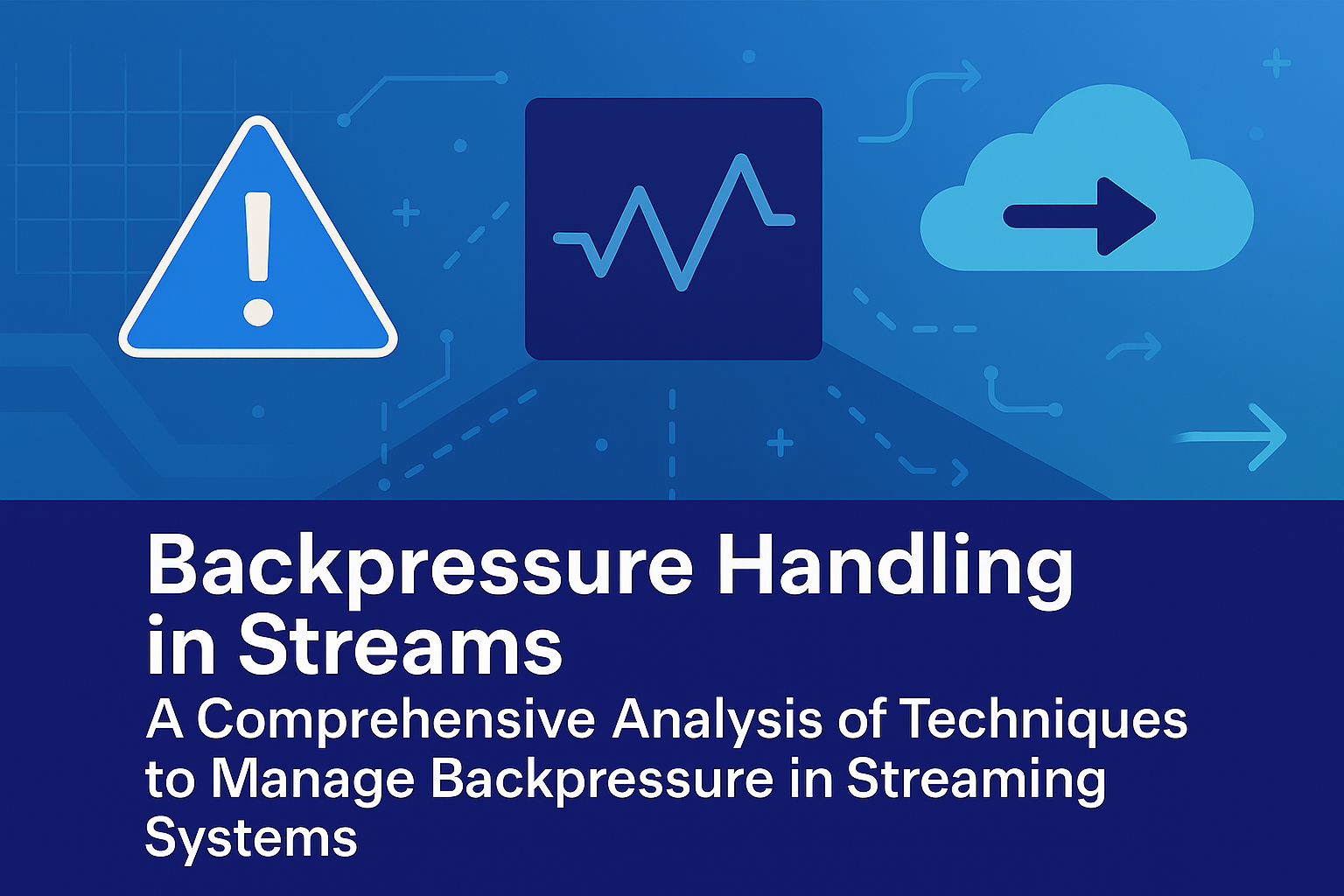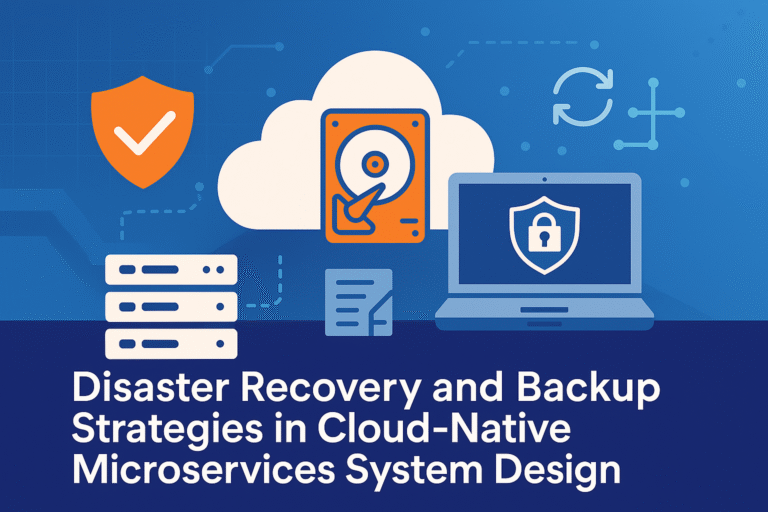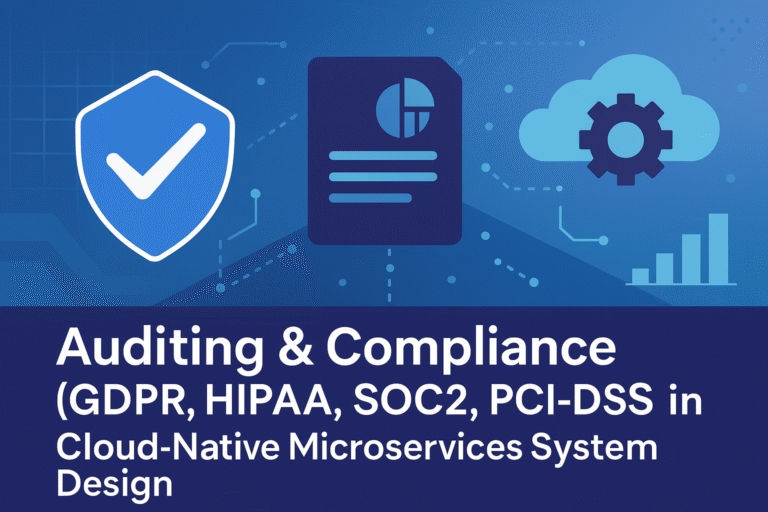Introduction
In streaming systems, backpressure refers to the buildup of data when the rate of incoming events exceeds the processing capacity of downstream components, potentially leading to resource exhaustion, increased latency, or system failures. Backpressure handling is a critical mechanism to regulate data flow, ensuring stability, scalability, and reliability in event-driven architectures. It is particularly relevant in high-throughput environments where producers generate data faster than consumers can process it, such as in real-time analytics, IoT data ingestion, or financial transaction monitoring. Effective backpressure management prevents overload while maintaining low latency (< 10ms for event processing) and high availability (99.99% uptime), aligning with the CAP Theorem by favoring availability and partition tolerance in AP systems. This analysis explores backpressure in depth, including its causes, mechanisms, techniques, applications, advantages, limitations, trade-offs, and strategic considerations. It integrates prior concepts such as message queues (e.g., Kafka for buffering), Change Data Capture (CDC) (for controlled data ingress), quorum consensus (for coordinated flow control), multi-region deployments (for global resilience), capacity planning (for resource forecasting), rate limiting (e.g., Token Bucket for producer throttling), load balancing (e.g., Least Connections for consumer scaling), failure handling (e.g., retries with idempotency), and single points of failure (SPOFs) avoidance (through replication), providing a structured framework for system architects to design resilient streaming systems.
Understanding Backpressure
Definition and Causes
Backpressure occurs when the production rate of data events outpaces the consumption or processing rate, resulting in a backlog that can propagate upstream and degrade system performance. In formal terms, it represents a feedback loop where downstream components signal upstream producers to slow down or pause data flow.
Key causes include:
- Imbalanced Throughput: Producers generating events at a high rate (e.g., 1M events/s from IoT sensors) while consumers process at a lower rate (e.g., 500,000 events/s due to complex computations).
- Resource Constraints: Downstream nodes facing CPU/memory exhaustion (e.g., 80% utilization triggering slowdowns) or network bottlenecks (e.g., 1 Gbps limit exceeded).
- Failure Scenarios: Partial failures (e.g., a consumer node crash) or network partitions (per CAP Theorem) reducing effective processing capacity.
- Spike Overloads: Sudden traffic surges (e.g., 2x normal load during peak hours) without adequate rate limiting.
- Stateful Processing: Accumulation in stateful operations (e.g., windowed aggregations in Kafka Streams holding 1GB of state).
Backpressure Modeling: Queue_Depth(t) = Input_Rate(t) − Output_Rate(t), where sustained positive values indicate overload
If unchecked, this leads to exponential latency growth, as per Little’s Law: L = λ × W, where L is queue length, λ is arrival rate, and W is average wait time
Importance in Streaming Systems
Backpressure handling is vital for:
- System Stability: Prevents cascading failures (e.g., overload propagating from consumers to producers).
- Scalability: Allows dynamic adjustment to varying loads (e.g., auto-scaling consumers via capacity planning).
- Fault Tolerance: Integrates with heartbeats (e.g., 1s interval) for liveness detection and failure handling (e.g., rerouting via load balancing).
- Consistency: Maintains eventual consistency in AP systems by controlling flow, reducing data loss risks.
- Performance Optimization: Reduces latency spikes (< 50ms P99) and ensures high throughput (1M events/s).
Without backpressure, systems risk exhaustion, as seen in unthrottled IoT streams overwhelming Kafka consumers.
Techniques for Managing Backpressure
1. Buffering
- Mechanism: Use queues or buffers to temporarily store excess events, allowing consumers to catch up. Buffers have thresholds (e.g., 10,000 events) to prevent unbounded growth, integrating with rate limiting (e.g., Token Bucket) to cap ingress.
- Implementation: In Kafka, consumer groups buffer events in memory/disk; overflow triggers backpressure signals upstream.
- Mathematical Foundation: Buffer size = max_lag × input_rate (e.g., 100ms lag × 1M events/s = 100,000 events).
- Advantages: Simple, absorbs short bursts (< 1% throughput loss).
- Limitations: Unbounded buffers risk OOM; requires monitoring (e.g., queue depth > 80% alerts).
- Example: A manufacturing IoT system buffers sensor data in Kafka during peak production, using GeoHashing for partitioned storage.
2. Dropping Events
- Mechanism: Discard excess events when buffers exceed thresholds, prioritizing critical events (e.g., via priority queues). Uses unique IDs (e.g., Snowflake) for idempotent drops.
- Implementation: In Pulsar, set TTL on messages; non-critical events expire.
- Mathematical Foundation: Drop rate = (input_rate – output_rate) / input_rate (e.g., 10% drop at 1.1M input vs. 1M output).
- Advantages: Prevents overload, low complexity.
- Limitations: Data loss (e.g., < 1% critical), unsuitable for reliable systems.
- Example: A video surveillance system drops low-priority frames during spikes, using rate limiting to control ingress.
3. Throttling (Rate Limiting)
- Mechanism: Limit producer rates (e.g., via Token Bucket or Leaky Bucket) to match consumer capacity, signaling backpressure upstream.
- Implementation: Kafka quotas limit producers (e.g., 10,000 messages/s/client); integrates with load balancing for even distribution.
- Mathematical Foundation: Token refill rate = consumer_rate (e.g., 1M tokens/s for 1M events/s).
- Advantages: Maintains stability, prevents lag (< 100ms).
- Limitations: Reduces throughput during limits, requires tuning.
- Example: A banking app throttles transaction events to Kafka, using quorum consensus for broker coordination.
4. Backpressure Signals (Reactive Streams)
- Mechanism: Consumers signal producers to slow down (e.g., via acknowledgments in Reactive Streams spec), integrating with failure handling (e.g., retries).
- Implementation: In Flink, consumers request batches based on capacity; uses heartbeats for liveness.
- Mathematical Foundation: Request size = min(buffer_capacity, available_credits) (e.g., 1,000 events per signal).
- Advantages: Dynamic flow control, high efficiency.
- Limitations: Requires protocol support, adds complexity.
- Example: A logistics tracking system uses Reactive Streams in Kafka consumers to signal sensor producers during overloads.
5. Scaling Consumers
- Mechanism: Dynamically add consumers (e.g., via auto-scaling) to increase processing rate, using load balancing (e.g., Least Connections).
- Implementation: Kafka consumer groups rebalance on addition (< 5s), monitored via capacity planning.
- Mathematical Foundation: Scaled throughput = initial_throughput × scale_factor (e.g., 1M/s × 2 = 2M/s).
- Advantages: Handles sustained load increases.
- Limitations: Scaling lag (10–30s), increased costs.
- Example: An e-commerce platform scales Kafka consumers during sales, using GeoHashing for regional data.
6. Dead-Letter Queues (DLQs)
- Mechanism: Route unprocessable events to DLQs for later analysis, integrating with idempotency for retries.
- Implementation: Kafka DLQs store failed events; consumers retry with backoff.
- Mathematical Foundation: Retry success = 1 – failure_rate^retries (e.g., 99% success with 3 retries at 10% failure).
- Advantages: Prevents blockage, aids debugging.
- Limitations: Adds storage (e.g., 10% of main queue).
- Example: A healthcare monitoring system routes failed sensor events to DLQs, checked via CDC.
Use Cases with Real-World Examples
1. Real-Time Fraud Detection in Financial Services
- Context: A bank processes 500,000 transactions/day, needing immediate fraud alerts.
- Implementation: Transactions stream to Kafka (20 partitions), processed by Flink with buffering (threshold 10,000 events) and throttling (Token Bucket at 100,000/s). Backpressure signals pause producers during spikes, with DLQs for failed events. Multi-region replication ensures global access, quorum consensus (KRaft) for coordination.
- Performance: < 10ms latency, 500,000 events/s, 99.999% uptime.
- Trade-Off: Buffering absorbs bursts but risks memory overload (mitigated by scaling).
2. IoT Sensor Monitoring in Manufacturing
- Context: A factory handles 1M sensor readings/s, needing anomaly detection without downtime.
- Implementation: Sensors produce to Kafka topics; Flink consumers use Reactive Streams for backpressure signals, dropping non-critical events if buffers exceed 5,000. GeoHashing partitions by location, rate limiting caps ingress, and capacity planning forecasts compute (10 nodes for 1M/s).
- Performance: < 10ms latency, 1M readings/s, 99.999% uptime.
- Trade-Off: Dropping events loses data but prevents overload (mitigated by prioritizing critical sensors).
3. Video Streaming Analytics in Media Platforms
- Context: A streaming service analyzes 1B user interactions/day for recommendations.
- Implementation: Interactions stream to Kafka; Spark Streaming consumers use throttling (Leaky Bucket at 200,000/s) and scaling (auto-add consumers at > 70% CPU). Backpressure via buffering (20,000 events threshold) integrates with load balancing for even distribution.
- Performance: < 50ms latency, 1B events/day, 99.999% uptime.
- Trade-Off: Scaling adds cost ($0.05/GB/month) but ensures performance during peaks.
4. Logistics Supply Chain Tracking
- Context: A logistics firm tracks 500,000 shipments/day, needing real-time delay alerts.
- Implementation: Shipment events to Kafka; consumers use backpressure signals (Reactive Streams) and DLQs for overloads. GeoHashing for location-based routing, CDC for database sync, and multi-region replication for global visibility.
- Performance: < 50ms latency, 500,000 events/s, 99.999% uptime.
- Trade-Off: DLQs add storage but enable recovery (mitigated by purging after 7 days).
Integration with Prior Concepts
- CAP Theorem: Backpressure favors AP by maintaining availability during overloads (e.g., buffering in Kafka).
- Consistency Models: Eventual consistency allows backpressure without blocking (e.g., lag in streams), strong consistency requires coordinated throttling.
- Consistent Hashing: Distributes backpressure signals across nodes.
- Idempotency: Ensures safe retries during backpressure (e.g., unique IDs in events).
- Heartbeats: Detects overloaded consumers for scaling.
- Failure Handling: Retries with backoff integrate with backpressure.
- SPOFs: Replication avoids SPOFs in streaming brokers.
- Checksums: SHA-256 verifies event integrity during buffering.
- GeoHashing: Routes location events to avoid regional backpressure.
- Load Balancing: Least Connections balances consumer load.
- Rate Limiting: Token/Leaky Bucket as backpressure mechanisms.
- CDC: Feeds streams without causing backpressure via controlled capture.
- Multi-Region: Backpressure signals propagate across regions.
- Capacity Planning: Forecasts buffers (e.g., 10,000 events) and scaling thresholds.
Trade-Offs and Strategic Considerations
- Stability vs. Data Loss:
- Trade-Off: Buffering and throttling maintain stability but may delay processing (10–50ms); dropping events prevents overload but risks loss (< 1% critical).
- Decision: Use buffering for reliable systems (e.g., banking), dropping for non-critical (e.g., video analytics).
- Interview Strategy: Justify buffering for fraud detection, dropping for surveillance.
- Latency vs. Throughput:
- Trade-Off: Backpressure reduces throughput to maintain low latency (< 10ms); ignoring it increases latency (> 50ms) but sustains throughput (1M/s).
- Decision: Prioritize latency in real-time apps (e.g., manufacturing), throughput in analytics.
- Interview Strategy: Propose throttling for banking, scaling for IoT.
- Complexity vs. Flexibility:
- Trade-Off: Reactive Streams offer flexible control but add complexity (10–15% overhead); simple dropping is easy but inflexible.
- Decision: Use Reactive Streams for dynamic workloads, dropping for simple.
- Interview Strategy: Highlight Reactive Streams for streaming platforms.
- Cost vs. Resilience:
- Trade-Off: Scaling consumers increases resilience but raises costs ($0.05/GB/month); dropping reduces costs but risks data loss.
- Decision: Scale for critical streams, drop for low-value.
- Interview Strategy: Justify scaling for logistics, dropping for non-essential logs.
- Global vs. Local Optimization:
- Trade-Off: Multi-region backpressure ensures global resilience but adds latency (50–100ms); local handling is faster but risks regional overloads.
- Decision: Use multi-region for global apps, local for regional.
- Interview Strategy: Propose multi-region for e-commerce.
Advanced Implementation Considerations
- Deployment: Use Kubernetes for stream processors (e.g., Flink) with 10 nodes (16GB RAM).
- Configuration:
- Buffers: Threshold 10,000 events.
- Throttling: Token Bucket at 100,000/s.
- Scaling: Auto-scale at > 70% CPU.
- Performance Optimization:
- Use SSDs for < 1ms I/O in buffers.
- Pipeline signals for 90% RTT reduction.
- Cache states in Redis (< 0.5ms access).
- Monitoring:
- Track lag (< 100ms), throughput (1M/s), and buffer depth with Prometheus/Grafana.
- Alert on > 80% utilization via CloudWatch.
- Security:
- Encrypt events with TLS 1.3.
- Use IAM/RBAC for access.
- Verify integrity with SHA-256 (< 1ms).
- Testing:
- Stress-test with JMeter for 1M events/s.
- Validate backpressure with Chaos Monkey (e.g., induce overloads).
- Test lag and recovery scenarios.
Discussing in System Design Interviews
- Clarify Requirements:
- Ask: “What’s the event rate (1M/s)? Latency target (< 10ms)? Data loss tolerance (0%)? Global or local?”
- Example: Confirm 1M readings/s for manufacturing with low latency.
- Propose Technique:
- Buffering: “Use for short bursts in banking fraud detection.”
- Throttling: “Use Token Bucket for e-commerce spikes.”
- Scaling: “Auto-scale consumers for video analytics.”
- Example: “For IoT, implement Reactive Streams with buffering.”
- Address Trade-Offs:
- Explain: “Buffering absorbs bursts but risks memory overload; dropping prevents overload but loses data.”
- Example: “Use buffering for fraud, dropping for surveillance.”
- Optimize and Monitor:
- Propose: “Tune thresholds to 10,000, monitor lag with Prometheus.”
- Example: “Track manufacturing buffer depth for optimization.”
- Handle Edge Cases:
- Discuss: “Use DLQs for persistent failures, scale for sustained loads.”
- Example: “For logistics, use DLQs for delayed shipments.”
- Iterate Based on Feedback:
- Adapt: “If data loss is intolerable, use throttling; if cost is key, use dropping.”
- Example: “For video platforms, add scaling if throughput increases.”
Conclusion
Backpressure handling is indispensable in streaming systems to manage overloads, ensuring stability, scalability, and performance. Techniques like buffering, dropping, throttling, backpressure signals, scaling, and DLQs provide flexible solutions, each suited to specific scenarios. Integration with concepts like rate limiting, CDC, and quorum consensus enhances resilience, while trade-offs like stability vs. data loss guide selection. Real-world examples in financial fraud, manufacturing monitoring, and logistics illustrate practical applications, achieving < 10ms latency and 99.999% uptime. By aligning with workload demands and monitoring metrics, architects can design robust streaming systems for high-scale environments.




